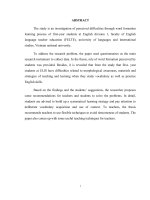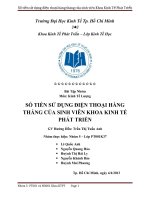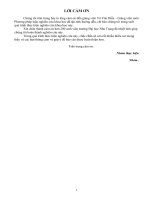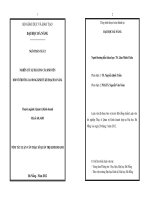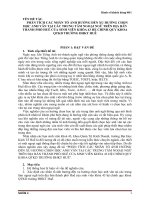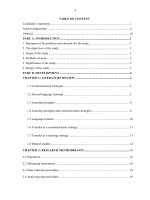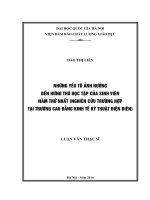Sử dụng hoạt động nhóm để cải thiện kỹ năng nói của sinh viên năm thứ nhất trường Cao đẳng Kinh tế-Kỹ thuật Thương mại
Bạn đang xem bản rút gọn của tài liệu. Xem và tải ngay bản đầy đủ của tài liệu tại đây (580.53 KB, 53 trang )
4
TABLE OF CONTENT
Declaration..................................................................................................................................i
Acknowlegements......................................................................................................................ii
Abstract....................................................................................................................................iii
Table of contents .....................................................................................................................iv
Part 1. Introduction .................................................................................................................1
Part 2. The development of the research
Chapter I. Literature review ...................................................................................................3
1. Theoretical background of speaking .............................................................................3
1.1. Nature of speaking skill ..........................................................................................3
1.2. Teaching Speaking skill in CLT Approach ….........................................................4
1.3 Communicative activities and features of communicative activitiies…...................6
1.4. Problems with speaking activities .........................................................................10
2. Group work.... ............................................................................................................11
2.1. Definition of group work. .....................................................................................12
2.2. Group size .............................................................................................................12
2.3. Group work activities. ...........................................................................................13
2.4. The advantages of group work. .............................................................................14
2.5. Some problems and suggested solutions in utilizing group work..........................15
2.6. Successfully implementing group work: Tips ......................................................16
Chapter II. The research .......................................................................................................18
1. The context .................................................................................................................18
2. The methodology .......................................................................................................18
2.1. The participants. ....................................................................................................18
2.2. Data collection. .....................................................................................................19
3.3. Data analysis and reflection. .................................................................................19
3. Action research process .............................................................................................20
3.1. Cycle one...............................................................................................................20
3.1.1. Initiation..................................................................................................21
3.1.2. Preliminary investigation........................................................................21
3.1.3. Hypothesis...............................................................................................21
5
3.1.4. Intervention.............................................................................................22
3.1.5. Data collection........................................................................................22
3.1.6. Data analysis and reflection ...................................................................23
3.2. Cycle 2 ..................................................................................................................25
3.2.1. Initiation..................................................................................................25
3.2.2. Preliminary investigation........................................................................25
3.2.3. Hypothesis...............................................................................................26
3.2.4. Intervention.............................................................................................26
3.2.5. Data collection........................................................................................26
3.2.6. Data analysis and reflection....................................................................27
3.3. Summary of the findings .......................................................................................30
Part 3. Conclusion, suggestions and limitations ..................................................................31
1. Conclusion ...............................................................................................................31
2. Suggestions……………...........................................................................................31
3. Limitations…………………………........................................................................32
4. Recommendation for further study ……..................................................................33
References ..................................................................................................................................I
Appendixes............................................................................ ...................................................II
6
PART 1
INTRODUCTION
RATIONALE
Speaking is one of the most important skills that most learners of any foreign
languages wish to achieve. It is an important skill that 'makes you a more fluent language
user; speaking is a chance to notice the gaps between what you want to say and what you can
say; it is a chance to test hypotheses about language' (Marilyn Lerris, 1999-quoted by He
Lina) . At the college of Economics, Technology and Trade (CTET), English has been taught
as a compulsory subject for more than 10 years. All of the students are non-majored English
students. And speaking is a problem for most of them. During the speaking lessons, the
students here usually keep silence whenever I ask them to say something in English they just
say yes/no to this kind of questions and encouter a lot of difficulties with open- ended
questions such as 'why' or 'what do you think...?'; most of them feel nervous with speaking
practice exercises.
Although our students start with the beginner level of English when they enter the
college and are supposed to obtain the pre- intermediate level after graduation, just a small
amount of them are capable enough of communicating in English. In fact, our students are
more competent in reading, writing, and listening to English but not in speaking English and
they think it is their biggest problem in learning English. Why is this the case? This can be
blamed on some reasons: the effect of entrance examinations, the students‟ characteristics of
being quiet and shy, the teachers' difficulties in controlling oral communication activities in
large classes, or the lack of oral communicative activities in the textbooks...
Due to the researcher's teaching experience, she realises that her students are afraid of
making oral mistakes, because they think their mistakes cannot be 'erased' once they are
uttered out. Anxiety in speaking Enlish is a real problem. And the oral activities done in the
English class are often irrelevant to their daily life. These two obstacles prevent the students
from learning to speak in English.
Therefore this minor thesis focuses on studying these students' problems in the
English speaking class and suggests some teaching techniques and strategies that can be used
7
to overcome these problems by using group work to reduce anxiety and encourage
communication among these students. The researcher decided to carry out the research work
entitled "Using group work to improve speaking skill of the first year students at the College
of Technology and Economics in Trade".
SCOPE OF THE STUDY
The study examines how to use group work to improve the speaking skill of the first
year students at the CTET.
OBJECTIVES OF THE STUDY
The study aims to:
1. Find out the reasons for some problems in speaking lessons
2. Offer group work as a key to improve speaking skill of the first year students at
CTET.
RESEARCH QUESTIONS
1. What are the problems in speaking lessons?
2. Can group work help to improve speaking skill?
DESIGN OF THE STUDY
The study will be designed as follow:
Part 1: Introduction which presents the rationales, the scope, the objectives, the
methods and design of the sudy.
Part 2: The development of the research
Chapter 1: Literature review
Chapter 2: The research
Part 3: Conclusion, suggestions, limitations
PART 2
8
THE DEVELOPMENT OF THE RESEARCH
CHAPTER 1: LITERATURE REVIEW
1. Theoretical background of speaking
1.1. Nature of speaking skill
Speaking is an interactive process of constructing meaning that involves producing
and receiving and processing information (Brown, 1994b; Burns & Joyce, 1997). Chaney and
Burk (1998, p.13) also argues that speaking is "the process of building and sharing meaning
through the use of verbal and non-verbal symbols, in a variety of contexts". Referring to
speaking or communication in language teaching and learning, Brown (1994b) affirms that
interaction is the heart of communication; it is what communication is all about, for example
in the cases of sending messages; receiving them; interpreting them in a context; negotiating
meanings; and collaborating to accomplish certain purposes. And interaction is the
collaborative exchange of thoughts, feelings, or ideas between two or more people resulting in
a reciprocal effect on each other. Bygate (1997, p.115) emphasizes that “interaction is the use
of language for maintaining communication between participants’ and ‘interaction skills are
skills of deciding what to say, when to say it and how to say it clearly”. Therefore, in speaking
process, learners are required to know not only how to produce specific points of language
such as grammar, pronunciation, or vocabulary (linguistic competence), but also when, why
and in what ways language is produced (sociolinguistic competence).
Gower et al.(1995, pp.99-100) state the two main aspects of the speaking skill
including “accuracy” and “fluency”. It is said that accuracy involves the correct use of
vocabulary, grammar and pronunciation. Accuracy if the focus of controlled and guided
activities with which students are also encouraged to attempt to use the language items they
have learnt in order to communicate accurately. Whereas, in Richards et. al (1993, pp.141142)‟s opinion, fluency refers to the level of communication proficiency which “includes (a)
the ability to produce written and/ or spoken language with ease; (b) the ability to speak with
9
good but not necessarily perfect command of intonation, vocabulary and grammar; (c) the
ability to produce continuous speech without causing comprehension difficulties or a
breakdown of communication”. Gower et. al (1995, pp.99-100) describe fluency as “the
ability to keep going when speaking spontaneously”. In order to get the message across,
language students need to make use of whatever knowledge, resources and ability they have
got, regardless of grammatical and other mistakes. They also need to employ different
strategies such as the use of natural-sounding „incomplete‟ sentences “I went to the cinema
last night. Did you? With whom?”; the use of common expressions like “I see/ Never mind”;
the use of fillers and hesitation devices “Well, let me think/ Let me see”; the use of
communication strategies such as for clarification; the ability to paraphrase; the use of useful
expressions such as “That reminds me…../ By the way,……./ Anyway………/ Strange,
really………. ” when finishing with a topic; and “Well I must go./ Nice talking to you.” when
finishing a conversation.
1.2. Teaching Speaking skill according to CLT Approach
According to Nunan (2003), what is meant by teaching speaking is to teach ESL
learners to produce the English speech sounds and sound patterns, to use word and sentence
stress, intonation patterns and the rhythm of the second language, to select appropriate words
and sentences according to the proper social setting, audience, situation and subject matter, to
organize their thoughts in a meaningful and logical sequence, to use language as a means of
expressing values and judgments and to use the language quickly and confidently with few
unnatural pauses, which is called as fluency.
Now many linguistics and ESL teachers agree on that students learn to speak in the L2
by interacting. Communicative language teaching (CLT) and collaborative learning serve best
for this aim. CLT is based on real-life situations that require communication. By using this
method in ESL classes, students will have the opportunity of communicating with each other
in the target language (Kayi, 2006). CLT has been an influential approach for the last decades
with the aim of “learn to communicate by communicating” (Larsen-Freeman, 1986, p.131).
According to Canale (1983, p.5), communicative competence - the final target of CLT - refers
to “the underlying systems of knowledge and skill required for communication”. Moreover,
“communicative competence is the aspect of our competence that enables us to convey and
10
interpret messages and to negotiate meanings interpersonally within specific contexts”
(Brown, 1994a, p.227). The concept of communicative competence is also described in terms
of four dimensions which are grammatical competence (grammatical and lexical capacity),
sociolinguistic competence (the ability to understand and produce appropriate language in the
social context which the communication happens) and discourse competence (the ability to
employ communicative strategies to initiate and redirect communication).
Besides, three key pedagogical principles that developed around CLT were the
presentation of language forms in context, the importance of genuine communication and the
need for learner-centered teaching. Hadfield (1990) suggests that a meaningful use of
language over its form means that accuracy and acquisition of the formal features of L2 are
less a measure of successful language learning than are fluency and ability to get something
across comprehensibly to a native speaker. In order to encourage meaningful language use,
many communicative activities involve elements of puzzle-solving or simulation.
A more successful realization of communicative principles is perhaps found in both
content-based and task-based teaching programs. Content-based programs involve the
teaching of subject matter content in the target language. According to Stern (1983), it is
closer to the communicative reality of the target language than classroom activities that are
only designed to have certain characteristics of natural discourse. It also has the potential to
be more motivating of learners given they have a degree of interest in the subject matter.
While task-based learning is a more resolutely communicative application of CLT principles,
it advocates the use of a syllabus based on communicatively oriented tasks rather than
linguistics forms. And its aim is to help students to develop the necessary language skills in
order to negotiate meaning in various interactions. In practice, learners are progressing
towards a clear goal by undertaking different kind of language activities or real-word tasks in
classroom settings. Crookes (1986, p.1) defines task as “a piece of work or an activity, usually
with a specific objective, undertaken as part of an educational course, at work or used to
elicit data for research”. Long (1985, p.89) seems to hold the same view when he says that
“by task is meant the hundred and one things people do it everyday life, at work, at play and
in between”. According to Phillis (1981, p.932), task is “to help the student to acquire
appropriate patterns of behaviors”. The above definitions state that task-based language
11
involves realistic communicative language use in which learners are asked to focus on
meaning rather than language structure and gives possibility to acquire “the ability to perform
certain communicative functions through a new medium” (Coupland, 1984, p.12).
Task-based teaching is based on learners‟ communicative needs; therefore the use of
needs analysis is required. Needs analysis helps teachers to define the exact interests and
preferences of the target group. The information acquired enables the teachers to plan an
effective and motivating curriculum, for the interest of the learners. Prabhu (1987) suggests
three different task-based activity types including information-gap activities (each student has
a part of the total information that they have transferred verbally to each other), reasoning-gap
activity (students derive some new information from information through the process of
inference, deduction, practical reasoning, or a perception of relationship or patterns) and
opinion-gap activity (students are engaged in identifying and articulating a personal
preference, feeling or attitude in response to a given situation).
Generally speaking, while participating in task-based or contented-based teaching in
CLT approach, learners gain experience how to communicate, solve problems, find out
information, organize and present information logically. So that the teacher can flexibly pick
up either task-based program or contented-based one or combine both of them in different
teaching context.
1.3 Communicative activities and features of communicative activities
1.3.1 Communicative activities
Traditional classroom speaking practice often takes the form of drills in which one
person asks a question and the other gives an answer. The question and the answer are
structured and predictable, and often there is only one correct, predetermined answer. The
purpose of asking and answering the question is to demonstrate the ability to ask and answer
the question.
In contrast, the purpose of real communication is to accomplish a task, such as
conveying a telephone message, obtaining information, or expressing an opinion (National
Capital Language Resource Center, nd). In real communication, participants must manage
12
uncertainty about what the other person will say. Authentic communication involves an
information gap; each participant has information that the other does not have. In addition, to
achieve their purpose, participants may have to clarify their meaning or ask for confirmation
of their own understanding. So well-prepared communicative activities will contribute to
students‟ self-confidence and to their motivation to learn more.
Communicative activities, defined by Harmer (1991), are those that give students who
are somehow involved in both the desire to communicate and a purpose involving them in a
varied use of language. Harmer (1991) identifies oral communicative activities into eight
categories: reaching consensus, discussion, relaying instructions, communication games,
problem solving, talking about you, simulation, and role-play. Obviously, communicative
activities are varied and the motivating value of each one may not be alike.
When applying communicative activities into speaking class, Brown (1994b, p.23)
reminds language teachers of “the eventual success that learners attain in a task is at least
partially a factor of their belief that they indeed are fully capable of accomplishing the task”.
Therefore, communicative activities must be sequenced from easier to more difficult.
Moreover, Maehr (1984) points out that certain activities are more motivating and interesting
to students than the others. Gagne (1985) states that students‟ motivation to participate in
activities is one of important types of motivation, it is essential to consider what kind of
activities can enhance students‟ motivation on learning language. At the same time, Lawtie
(2004, p.1) also strongly believes in the important role of the right activities in speaking class
when arguing that “if the right activities are taught in the right way, speaking in class can be
a lot of fun, raising general learner motivation and making the English language classroom a
fun and dynamic place to be”. Indeed, students need to be provided with activities that they
are interested in solving, and they are most likely to solve them in a supportive, non
threatening environment (Sadow, 1982). Classroom activities not only need to be relevant to
students, they also need to be interesting and address multiple intelligences and creative
thinking. As every experienced teacher knows, learners do best at things that interest them
(Rubin, 1985). Moskowitz (1978) and Scarcella and Oxford (1992) point out that one of
meaningful and interesting activities which can motivate students to learn is so-called self
13
expression activities (SEA). Students have opportunities to express themselves in these
activities.
According to Glasser (1985)‟s Control Theory of motivation, everyone is motivated
by the need to satisfy one of five basic needs - survival, belonging, power, freedom, and fun.
Farris (1990) relates Glasser‟s Control Theory to student needs and possible solutions. To
satisfy students‟ need to belong, a classroom with an accepting atmosphere should be created,
and teaching should be in groups, using cooperative learning strategies. To satisfy the need
for freedom, Farris suggests involving students in rule-making, providing opportunities for
free expression, and encouraging creativity. To satisfy the need for power, create a studentcentered classroom, and give students choices when possible. To satisfy the need for fun, use
games and simulations, and encourage students to have a good time learning. Basing on the
background, SEA as mentioned above will be put under experiment to see whether they can
motivate students in speaking class by satisfying some basic needs like belonging, freedom,
fun, and power.
In order to clarify that communicative activities are effective and motivating, Ur
(1996, p.120) lists out some necessary characteristics of them. First, “learners talk a lot”
which means as much as possible of period of time allotted to the activity is in fact occupied
by learners‟ talk. Second, “participation is even”. In other words, classroom discussion is not
dominated by a minority of talkative students: all get a chance to speak, and contributions are
evenly distributed. Next, “motivation is high” which can be understood that learners are eager
to speak because they are interested in the topics and have something new to say about it, or
because they want to contribute to achieving a task objective. Finally, “language is of an
acceptable level”. It means that learners express themselves in utterances that are relevant,
easily comprehensible to each other, and of an acceptable level of language accuracy.
Harmer (1999) adds that communicative activities must have some communicative
objectives that students must try to achieve since the most important part of any
communication is a desire to communicate and a purpose to achieve. The aim of
communicative activities is to encourage purposeful and meaningful interaction between or
among studenG23
14
ts. They are designed to provide students with a reason or a purpose for speaking. By
successfully doing so, students are likely to try utmost to bridge the information and opinion
gap, ask for or find out their fellow students‟ opinion, or give necessary information.
In brief, communicative activities perform a very important role in language learning,
especially in learning to speak. It does help to improve students‟ motivation so it is necessary
to understand the overwhelming advantages of some oral activities over the others in terms of
motivation and interestingness.
1.3.2. Features of communicative activities
As mentioned above, to provide students with motivating and interesting activities, the
understanding of features of successful communicative activities is a necessity. The features
summarized by Nation (1989) include roles, outcomes, procedures, split information and
challenges. They aim to fulfill two tasks, one of which is to assist the achievement of the
learning goal and the other is to arouse more motivation and engagement in the activity.
The use of roles has certain impact on the learning goal as roles allow and encourage
the use of language, which is difficult or sometimes even impossible to be made happen in
classroom situation. Roles also help to generate more participation and involvement. Nation
(1989) points out that if roles are not in use, it would be difficult to sustain interest for long.
He also adds that in discussion students could be given responsibilities to suggest solutions,
summarize others‟ views or disagree with certain students. It means that students are provided
chances to express their different opinions on discussion. This promises a lot of interesting
surprises and fun.
Another characteristic of communicative activities is the outcome, which gives the
activities themselves a clear sense of purpose and thus generates more interest. Basic
outcomes listed by Nation (1989) are direction providing, ranking, ordering or implication
choosing and listing, causes or uses, matching, classifying, distinguishing and data gathering.
The others are problem solving and material producing.
The third feature of speaking activities is procedure, which helps to divide them into
steps. This is expected to bring about more participation in the tasks and typical example
15
could be a pyramid discussion, in which students are first paired up to work out one solution
or completion, then grouped into a larger group and finally required to work with the whole
class.
Spilt information is another feature of oral activities. Lying at the heart of
communication is the exchange of information and when the information is split either evenly
or unevenly among the learners communication must be attempted to obtain what each
participant needs.
Challenges, as the name suggests, is the feature aiming at making the activities more
demanding and thus more interesting. They all have game-like quality to lessen stress if it
happens to occur due to the challenges and ensure more interest and involvement. Challenges
could be competition, limitation of time or quantity, memory and hidden solution.
To conclude, communicative activities could be characterized with five above
categories. According to Nation (1989), the employment of one or a flexible combination of
some or all features could help teachers to improve the speaking activities or to create new
ones.
1.4. Problems with speaking activities
Classroom activities that develop learners‟ ability to express themselves through
speech are an important component of a language course where CLT is applied. However, it is
more difficult to design and administer such activities than to do so for listening, reading or
writing. According to Ur (1996, p.121), teachers often come across the following problems:
* The first is “inhibition”. It is explained that unlike reading, writing and listening
activities, speaking requires some degree of real-time exposure to an audience. Learners are
often inhabited about trying to say something in a foreign language in the classroom because
they are worried about making mistakes, fearful of criticism or losing face, or simply shy of
the attention that their speech attracts.
* Nothing to say is the second problem. Teachers often hear learners complain they
can not think of anything to say. They may have no motivation to express themselves beyond
16
the guilty feeling that they should be speaking. The problem is also mentioned by Lawtie
(2004) and it is necessary to be tackled.
* Moreover, uneven or low participation is among the teachers‟ obstacles. Only one
participant can talk at a time if he or she is to be heard. In a large group, this means that each
one has only very little time for talking. This problem is compounded by the tendency of
some learners to dominate the group, while the others speak very little or not at all.
* Last but not least, mother-tongue use is also problematic. When all, or a number of
the learners share the same mother tongue, they may tend to use it. This happens because it is
easier, because it is unnatural to speak to one another in a foreign language and because or
because learners feel less „exposed‟ if they are speaking their mother tongue. Lawtie (2003,
p.2) also states that the problem would happen if the task or activity is not “pitched at the right
level for the students”. If the language is pitched too high they may revert to their first
language, likewise if the task is too easy they may get bored and revert to the first language,
too.
To deal with the problems, Lawtie (2004) believes that as a teacher maybe you need to
take a closer look at the type of speaking activities in order to make the activities interesting
enough to capture students‟ interest and create a real need for communication.
In a word, overcoming these obstacles in speaking class to create successful speaking
activities where learners talk a lot, participation is even and motivation is high certainly
Requires a lot of teachers‟ efforts in designing and carrying out speaking activities.
2. Group work.
The EFL literature indicate that to improve our students' speaking skill, we must
reducing learner anxiety and ensuring meaningful communicative exchanges in the classroom.
And group work is one of the valuable techniques can help achieve the above goals for the
purpose of fostering speaking ability. Group work can create a comfortable atmosphere and
the intimate community necessary for learners to take risks in speaking.
17
2.1. Definition of group work.
Rod Killen (2004) indicades that 'Group work occurs when you ask two or more
students to work together.' Davis (1993) sorts out three types of group work which are called
: informal learning groups, formal learning groups, and study teams
Informal learning groups are ad hoc temporary clusterings of students within a single
class session. Informal learning groups can be initiated, for example, by asking students to
turn to a neighbor and spend two minutes discussing a question you have posed. You can also
form groups of three to five to solve a problem or pose a question. You can organize informal
groups at any time in a class of any size to check on students' understanding of the material, to
give students an opportunity to apply what they are learning, or to provide a change of pace.
Formal learning groups are teams established to complete a specific task, such as
perform a lab experiment, write a report, carry out a project, or prepare a position paper.
These groups may complete their work in a single class session or over several weeks.
Typically, students work together until the task is finished, and their project is graded.
Study teams are long-term groups (usually existing over the course of a semester) with
stable membership whose primary responsibility is to provide members with support,
encouragement, and assistance in completing course requirements and assignments. Study
teams also inform their members about lectures and assignments when someone has missed a
session. The larger the class and the more complex the subject matter, the more valuable study
teams can be.
2.2. Group size
It seems prudent to keep groups as small as possible to promote positive
interdependence, yet as large as necessary to provide sufficient diversity of opinions and
backgrounds as well as resources to get the job done. The size of groups formed is direct ly
dependent on the activity to be pursued and the length of time the group will stay together.
Typically, for in-lecture informal activities, group size is often kept small (in the range of two
to four students) since larger groups have insufficient time to become cohesive. In contrast, a
18
complex semester long project may require the resources of a larger group (four to six
students) and there is enough time for the group to become effective.
2.3. Group work activities.
There are some activities for group work activities:
- Games
- Question construction
- Guided practice
- Dictation
- Role play
- Guess ahead
- Speculative question
- Discussion
- Project
- Information gap
- Jigsaw
- Problem solving
- Discussion making
- Opinion exchange.
19
2.4. The advantages of group work.
The literature argues that group work creates and comfortable atmosphere and the
initiate community necessary for learners to take risk in speaking. So, how can group work
reduce anxiety, increase communication, and thus, foster greater speaking atmosphere?
Koichi (2003) points out that group work allows students to take the initiative in controlling
their communicative activities, thus, reducing anxiety, facilitating responsibility, creating
communitive, and smoothing progress of fluency as a result. Above all, group work with
fewer students than a whole class as one large group, create an intimate atmosphere.
A second, related, benefit is that group work creates a sense of security. As discussed,
students are afraid of looking silly in front of the other students though they have a desire to
improve their English. However, once they are in a small group, where they realize their
peers feel the same, Doyon (2000) believes that there is a tendency for students to use more
of their target language. Nimmannit (1998) offers another analysis of why students feel
secure in group work: ‘they [individual students] will not be the only ones to shoulder the
blame or to lose face if they answer incorrectly’.
The third advantage of group work is that it allows students to participate more and to
do so more actively. Tsui (2001) and Lee (1999) find that „group work provides more
opportunities for learners to initiate and control the interaction, to produce a much larger
variety of speech acts and to engage in the negotiation to meaning’ and that ‘being
responsible for their peers’ learning in a group makes students more active’.
To sum up, it is clear from the literature that group work offers potential advantages
which the teacher-centered class lacks: a friendly community, a relaxed atmosphere with a
sense of security ; and a more active and responsible attitude with more opportunities to
speak out.
20
2.5. Some problems and suggested solutions in utilizing group work.
Besides the aforesaid advantages, we must be realistic and assume that there might be
some problems. Killen (2006) suggests that it is common to have difficulties associated with
clarifying the goals of the groups, interactions within the groups, or motivations or emotions
of group members. He introduces Tiberius (1990) idea about the most common problems that
we may encounter and some solutions when implementing group work. These are:
- Some students may be more interested in talking about other things than becoming
involved in the group work. This may result from irrelevant activities or uninteresting topic.
To avoid it, teachers should plan carefully to make sure that the group work is relevant and
interesting for the students and they have been adequately prepared for it. Besides, teachers
should make sure that their expectations clear to students and occasionally speak quietly to
individual student to bring them back on task.
- One student may assume a dominant role in a group, either because she/ he wants to
lead or because the other students in the group are reluctant to participate. This problem
could be solved by developing the students‟ communication skills and by establishing clear
guidelines for how groups are to operate. By doing this we could encourage our students to
participate as equals. However, this takes lots of time to solve the problem, to help students
how to learn from the others.
Sometimes, it is useful to make the dominant student the group leader, but with a clear
guideline about the leader‟s role.
- On most occasions when we use small-group work we will want our students to
come to some conclusions which might be difficult. However, it is necessary to explain to
them that reaching conclusions is a process of making promises and that it is an important
part of working together.
21
2.6. Successfully implementing group work: Tips
However, effective group work in the classroom does not occur automatically. Indeed,
group work requires teachers‟ carefully involvement to be successful. The teachers‟ job
begins with the planning and preparation for the group work activity. There are three
requirements that the teachers must be aware of for the group work activity to be successful.
Great care, preparation, and thought on the part of the teacher are required to address these
requirements:
-
it is necessary for students to be well- prepared for negotiating.
-
it is necessary for their task to be open-ended.
-
it is necessary for their task to require discussion and cooperation of
students.
(Leki, 2001)
Hoekje adds to Leki‟s another requirement: it is necessary for teachers to inform
students of the importance of group work. That means students need to know the advantages
of group work or “They may feel that the English spoken by other students and themselves is
mistake-ridden and not worth listen to” (Hyde, 1993)
The second important tip is the teachers‟ centre role in the actual implementation of
group work. That is, once an activity begins, teachers‟ circulation from group to group is
critical, a technique by which the teachers can signal their accessibility. This accessibility is
indepensible for students to be motivated, because students‟ recognition of the helpfulness of
this activity depends on teachers‟ error correction and suggestions, which can provided only if
the teacher circulates among the group (Hoekji, 1993). The second role of the teacher during
the activity is to assign roles to each member of the group.
A third consideration that the teacher needs to keep in mind to make group work
successful is to arrange for frequent group change. Maclnyre, et al. (1988) identify variables
such as learner personality, intergroup climate, and intergroup motivation as among various
causes which can affect students‟ involvement in group activities. Hyde (1993) adds that
students sometimes obliged to share activities with classmates who do not want to talk to, and
that some students do not pay attention to what their peer says, insisting on their own
22
judgments and that ‘this unhappy experience may well becoming something of a nightmare if
regular changing was not to occur in class’
23
CHAPTER II: THE RESEARCH
1. The context.
1.1. The first year students.
All the students in the target class were admitted to the college after the entrance
examination to university. Although most of them had to study English at the secondary
schools and had to take an English test in their final exams but they do not have the same
level at English. Furthermore, they are all considered to be the new men in the subject and
have to study a set of textbooks from the elementary level. Therefore, better students do not
encounter many difficulties in getting acquanted with the new textbook and new teaching
methods, whereas the other students seem to get difficulties in learning English according to
the new textbook. These students mostly keep silent in English lessons.
1. 2. The textbook.
The main textbook for the first year students is Market Leader-Elementary. It includes
10 units with different topics which relate to business. The teachers have to cover the
textbook in 40 periods with 50 minutes for each period.
1. 3. The context of teaching.
Covering all the content of the textbook during the class hour is impossible for the
teacher. Therefore, they have to omit some simple parts and use them as students' homework
to focus on the main issues of the units. However, speaking tasks are never left out. Most of
the teachers pay a lot of attention to help their students to complete the speaking activities in
the textbook.
2. Methodology.
2.1. The participants.



